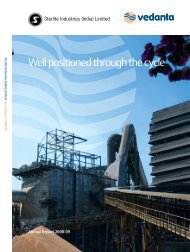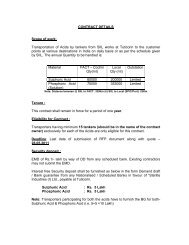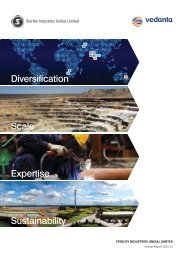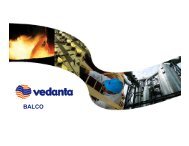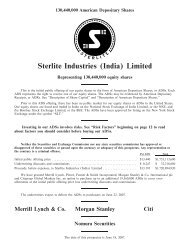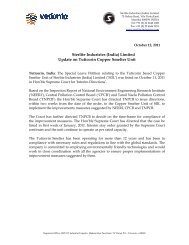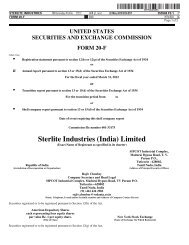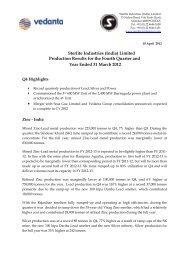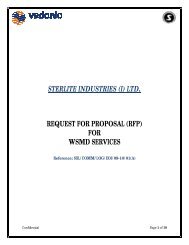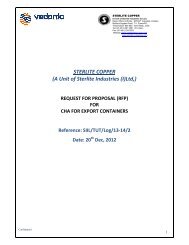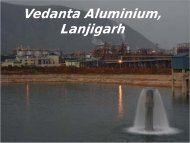Sterlite Industries (India) Limited - Sterlite Industries India Ltd.
Sterlite Industries (India) Limited - Sterlite Industries India Ltd.
Sterlite Industries (India) Limited - Sterlite Industries India Ltd.
Create successful ePaper yourself
Turn your PDF publications into a flip-book with our unique Google optimized e-Paper software.
Market Outlook<br />
Global Zinc Outlook<br />
According to Brook Hunt, the combination of stronger economic growth and restocking will result in zinc consumption growth increasing to<br />
an average of 6.5% per annum in 2011 and 2012. This increase in consumption will compensate for the current downturn and result in global<br />
zinc consumption growing at an average rate 1.5% per annum over the period from 2008 to 2012. The rate of consumption growth is forecast to<br />
decrease in subsequent years with global consumption forecast to contract by 1.6% in 2019, the year in which Brook Hunt also forecasts the<br />
next global economic downturn. For the period from 2012 to 2020 consumption growth is forecast to average at 3.7% per annum. As a result of<br />
these growth rates, global zinc consumption is forecast to reach 16.0 million tons in 2020, an increase of 4.6 million tons from 2007.<br />
In 2008, several mining companies were committed to mining projects that the previously strong resources sector and high metals prices<br />
made feasible, but the global economic crisis and concentrate supply shortages caused many of these mining companies to shut down or reduce<br />
the scale of their operations instead. Smelter expansions have also continued worldwide, but major smelter expansions and construction of new<br />
smelters have been deferred, except in China and <strong>India</strong>. Global zinc production is expected to decrease from 11.5 million tons in 2008 to<br />
10.7 million tons in 2010, as smelters exercise producer discipline and match output to market demand.<br />
<strong>India</strong>n Zinc Outlook<br />
The <strong>India</strong>n market outlook is expected to remain positive, with strong growth in key user segments such as sheet galvanizing and zinc alloys<br />
for the construction segment. Domestic consumption increased by 2.0% to 479,000 tons in 2008 and consumption growth for the period from<br />
2008 to 2010 is forecast to average 7.3% per annum.<br />
Aluminum<br />
Global Aluminum Market<br />
Background<br />
Aluminum is lightweight in relation to its strength, durability and resistance to corrosion. It can be extruded, rolled, formed and painted for a<br />
wide variety of uses. According to Brook Hunt, four end-use sectors accounted for approximately 77% of aluminum consumption globally in<br />
2008: construction, transport, packaging and electricals. The remaining 23% is accounted for by a wide variety of applications including<br />
machinery and equipment and consumer durables. Aluminum is also increasingly substituted for steel in the automobile industry to reduce<br />
weight and improve fuel economy.<br />
The raw material from which aluminum is produced is bauxite, which is a very common mineral found mainly in tropical regions. It<br />
normally occurs close to the surface and can be mined by open-pit methods. The bauxite is refined into alumina. Typically, bauxite ranges from<br />
35% to 60% contained alumina. There are several different types of bauxite, and alumina refineries are usually designed to treat a specific type.<br />
The majority of alumina refineries are therefore integrated with mines.<br />
Aluminum Consumption<br />
According to the Brook Hunt Aluminium Metal Service Report, May 2009, world primary aluminum consumption increased from<br />
34.4 million tons in 2006 to 38.0 million tons in 2007, an increase of 10.4%, and then remained at this level in 2008. This growth was primarily<br />
due to increased demand in China, which between 2005 and 2008 saw demand increase at a compound annual growth rate of 22.0%, compared<br />
to a a decline of 1.2% for world demand excluding China. Demand in North America rose just 0.6% between 2005 and 2006 and then<br />
decreased by 7.2% from 2006 to 2007 while in Western Europe the compound annual growth rate in demand between 2005 and 2007 was<br />
4.9%, in both cases reflecting the impact of a slowing economy in these regions. From 2007 to 2008, primary aluminum consumption in North<br />
America and Western Europe decreased by 8.2% and 3.9%, respectively, reflecting the effects of the global economic crisis.<br />
9



